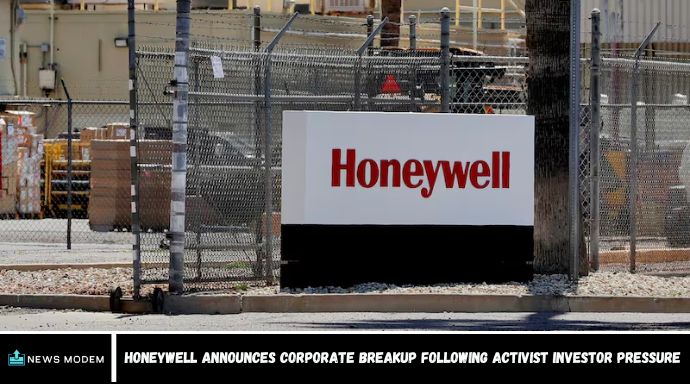Honeywell Announces Corporate Breakup Following Activist Investor Pressure Honeywell, one of the largest multinational conglomerates in the world, is undergoing a major corporate restructure following mounting pressure from activist investors. The company has announced plans to break up its operations, splitting into separate divisions to enhance value for shareholders. But what led to this decision, and what does it mean for the company and its future?
Honeywell (HON.O) has announced it will split into three independently listed companies, marking a significant move for one of the last remaining major U.S. conglomerates. This decision comes just months after activist investor Elliott Management acquired a $5 billion stake in the industrial giant. However, Honeywell’s stock dropped nearly 4% following the announcement, as the company projected weaker-than-expected results for 2025. Some experts warn that the benefits of this separation may take time to materialize.
On Thursday, Honeywell confirmed it will separate its aerospace and automation businesses into distinct entities, alongside the previously planned spin-off of its advanced materials unit.
This move further reduces the number of leading industrial conglomerates in the U.S., following similar restructurings in recent years by companies like 3M (MMM.N), General Electric (GE.N), and United Technologies. Tony Bancroft, a portfolio manager at Gabelli Funds (which holds Honeywell’s shares), stated that the aerospace and automation divisions could be valued at $104 billion and $94 billion, respectively. However, he cautioned that it may take time for the market to fully recognize the value of these splits.
Why Is Honeywell Breaking Up?
Pressure from Activist Investors: In recent years, Honeywell has faced increasing pressure from activist investors who believe the company’s current structure is limiting its growth potential. These investors argue that Honeywell’s broad range of businesses, which include aerospace, building technologies, and performance materials, should be divided into more focused, specialized companies. The belief is that splitting up would unlock more value for shareholders and allow each division to pursue its own growth strategy.
Honeywell’s Response: In response to this pressure, Honeywell has agreed to reorganize its operations into separate entities. This move is not entirely surprising as other major corporations have similarly opted for breakups, including General Electric and Johnson & Johnson. By splitting up, Honeywell aims to address concerns over inefficiencies and improve the company’s overall market value.
What Will Honeywell’s Split Look Like?
Three Key Divisions: Although the exact structure of the split has not been fully disclosed, Honeywell has indicated that it will likely divide its operations into three key segments:
- Aerospace: This division will focus on Honeywell’s aircraft, defense, and space technologies, a major area of revenue for the company.
- Building Technologies: This division will handle Honeywell’s smart building solutions and environmental technologies, such as energy-efficient products and automation systems.
- Performance Materials and Technologies: This division will cover Honeywell’s chemical production and advanced materials technology.
Each of these divisions will operate more independently, with their own leadership teams, allowing for more targeted decision-making and growth opportunities.
How Will This Affect Honeywell’s Stock Price?
Boost to Shareholder Value: Investors are hoping that the split will lead to increased shareholder value. Many experts argue that when conglomerates break up, their stock prices tend to increase because the newly independent divisions are able to focus more on their respective markets. This was seen in the cases of General Electric and Johnson & Johnson, where the spin-offs resulted in positive stock performance for shareholders.
Improved Focus: The new independent companies will be better equipped to focus on their unique markets and opportunities. Each division will be able to tailor its strategy to its own strengths, leading to more innovation and growth in the long term.
What Impact Will This Have on Employees and Operations?
Changes in Leadership: With each division becoming more autonomous, there will be changes in leadership. This could include new CEOs, management teams, and operational restructuring. While this can lead to uncertainty for employees in the short term, it also opens up new opportunities for leadership positions in the restructured companies.
Operational Efficiency: The breakup is expected to streamline operations. With each division able to focus on its specific niche, Honeywell hopes to improve overall efficiency. This could also lead to a more agile company culture, better able to adapt to changing market conditions.
Conclusion:
Honeywell’s decision to split up into separate divisions marks a significant shift in its business strategy. Driven by pressure from activist investors, the company is hoping that this restructuring will create more shareholder value, improve operational focus, and enhance growth opportunities for each division. While the immediate future may bring some uncertainty for employees and operations, the long-term outlook for Honeywell and its shareholders appears promising.
FAQ
1. Why is Honeywell splitting up?
Honeywell is restructuring to unlock shareholder value and improve focus, driven by pressure from activist investors.
2. What divisions will Honeywell split into?
Honeywell plans to split into aerospace, building technologies, and performance materials and technologies.
3. Will Honeywell’s stock price go up after the split?
Many analysts believe the split will boost Honeywell’s stock price by making the individual divisions more focused and market-driven.
4. How will employees be affected by the split?
Employees may see changes in leadership and management, but the split could also offer new opportunities in the independent divisions.
5. What do activist investors want from Honeywell?
Activist investors want Honeywell to break up its conglomerate structure, believing that more specialized companies will lead to higher profits and stock prices.
6. How does this compare to other companies?
Similar corporate splits by companies like General Electric and Johnson & Johnson have generally resulted in improved stock performance and growth for shareholders.








